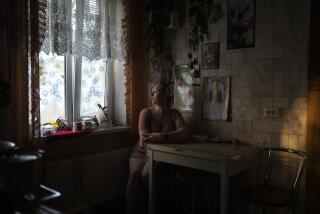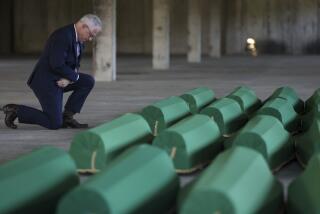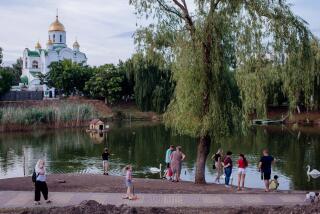On Bosnia’s Chessboard, Refugees Feel Like Pawns
- Share via
CAPLJINA, Bosnia-Herzegovina — Milka Stojanovic believes that her stay in this desolate Neretva River ghost town is a temporary inconvenience until peace is restored in her native city of Travnik. But Travnik is now securely in the hands of predominantly Muslim Bosnian government forces, and Stojanovic and thousands of other Travnik Croats are probably here to stay.
It is only now dawning on the recent arrivals to Capljina that their sudden relocation might not have been driven by Muslim invaders. In what amounts to self-inflicted “ethnic cleansing,” Bosnian Croat nationalists wrenched the civilians from their homes and evacuated them to other regions to establish Croatian pockets that could eventually be affixed to a Greater Croatia.
By expelling Serbs and Muslims from the Neretva valley and then relocating Croats from central Bosnian areas where they were the minority, Bosnian Croat leaders in nearby Mostar have created an ethnically pure Croatian province in this rocky, sun-scorched highland they call Herzeg-Bosna.
The only drawback in this first planned population transfer in pursuit of ethnic consolidation is that no one asked its participants what they thought about giving up their old homes.
“Not a single one of us wants to stay here,” Stojanovic declared tearfully, drawing confirming nods from dozens of other Travnik refugees. “We have our own land and beautiful houses, and all we want is to go back. . . . I don’t care if they’ve burned my house to the ground. The foundation will still be there and I can rebuild it.”
The Croatian HVO militia shepherded more than 5,000 Croats from Travnik across Serbian artillery lines in a two-day period when the formerly allied Croatian and Muslim forces clashed over control of the majority Muslim region.
The Travnik flare-up, which U.N. troops blamed on renegade Muslim forces backed by Islamic mercenaries, followed months of deadly battles over other mixed Croat-Muslim areas of central Bosnia that had been launched by HVO troops under Bosnian Croat leader Mate Boban’s control.
While the retaliatory government action in Travnik genuinely endangered Croatian civilians, international aid agency officials, U.N. soldiers and even some refugees say the mass flight resulted from HVO-induced hysteria.
“The HVO came on the radio and said the surrounding villages had been taken and we all had to flee, that we should get out immediately,” recalled Lubica Ejldic, 37, a clothing factory worker whose entire village of Paklarevo was herded by the HVO on foot over rugged Mt. Vlasic and across the heavily armed front line manned by Bosnian Serb separatists.
“My 16-year-old daughter, Anita, was terrified and crying,” said Ejldic, who fled with her three children. “The Serbs told her there was nothing to cry about, that we had made the right decision.”
Older men among the Capljina refugees, such as Stipo Didak, 53, said they were assured by HVO troops prodding them to flee to Serb-held territory that the rebels, who had been shelling Travnik for nearly a year, had been asked to grant safe passage to the escaping civilians. “Our commanders had had some discussions with the Serbs,” said Didak, suggesting the 4:30 a.m. roundup of civilians in his village of Kraljevica on June 6 was not a spontaneous evacuation.
Stojanovic said the Serbian gunmen had tea waiting for Croatian refugees when they arrived after their arduous trek across the mountains--a mass influx of purported enemies that produced not a single shot fired in anger.
The Serbs had trucks waiting to take the refugees across two front lines to the Croatian city of Novska, where they stayed for three days before a massive exchange was arranged under which hundreds of Serbian prisoners held in Bosnian Croat jails were released. The refugees were then bused around the length of Croatia and into this wasteland, where they were scattered among empty and ruined villages.
Nearly 300 have since been idling the steamy summer days at an unused elementary school in Capljina, a city cut in half by the Neretva River that has for centuries been the dividing line between Orthodox Serb communities and Catholic Croats.
“These are not the typical refugees we have dealt with in the Third World,” one official of the U.N. refugee agency said of the relocated Croats. “They had a lot more to lose, and they are going to be very resentful of having been made pawns in the land swaps going on among the political leaders.”
The former Travnik refugees are virtually unanimous in their refusal to consider the Neretva valley their new home, and those in rubble-strewn Capljina seem especially unhappy.
Capljina was a Yugoslav federal army garrison town, which made it an early battleground in the Bosnian war. Serbs destroyed much of the housing and industry on the west bank when the conflict began in April, 1992, and Croatian forces blasted virtually every Serb-owned structure in the eastern sector after recapturing it last summer.
The result is a ravaged landscape in which few would want to live, especially those accustomed to Travnik, a wealthy, wooded and verdant mountain enclave that was the seat of the Bosnian viziers during five centuries of Turkish rule.
Banished to this miserable backwater, the Travnik refugees in Capljina have grown anxious about their future and the evaporating likelihood that they will ever go home again.
“I would go back in a minute if I had the right to choose for myself,” said Anka Epit, 58, a mother of six. “I know I can’t do anything about the (Mostar) government that negotiates in our name. I just know I want to go back and live in my own house and that I would be shattered if the government negotiated an agreement that said I had to stay here.”
As part of a tentative peace deal forged in Geneva, leaders of Bosnia’s warring factions are trying to fashion a new map, partitioning the nation into three ethnic states.
But opposition politicians in neighboring Croatia warn that ethnic partitioning will only lead to more forced displacements and disillusioned people, making for an unstable peace in Bosnia and boosting the likelihood of a similar ethnic carve-up of Croatia.
More to Read
Sign up for Essential California
The most important California stories and recommendations in your inbox every morning.
You may occasionally receive promotional content from the Los Angeles Times.














